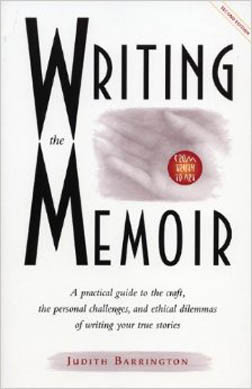Emphasizing structure
[Barrington’s short classic.]
I suppose like all writing teachers, I try to emulate certain teachers. But mostly I’m trying to be the teacher I wish I’d had. Someone who illuminates a genre and saves me from myself. The latter is too much to ask, I know. But here’s a secret. I think I’ve become a good teacher of memoir writing, at least for beginners.A key reason for my feeling of success is my evolving emphasis on structure. In my experience, green writers can produce creditable-to-impressive work if they focus not just on the story they want to tell but on how best to present it. Fine work ensues in my memoir classes if I show students framing, braiding, Hermit Crabs, and segmentation along with scenes and persona and the rest. Structure cracks open their material to themselves. Structure makes the eye-popping difference between a plodding chronology and a memoir essay enriched with layers and refreshing rhetorical moves.
I’m talking about receiving poignant and interesting work from a twenty-year-old. Someone who has read one novel for enjoyment in his life, whose grasp of grammar is shaky, and who has never willingly written. Much less taken a creative writing class. Maybe every teacher is doing that. If so, I’m conceited for suspecting I’m special. But amidst the very hard work of teaching, receiving such writing keeps me going. A kid’s essay may be a tad lumpy, a lopsided vase, especially the first draft, but it can also be—undeniably—art.
“Art is made of emotion, is about emotion, and asks for an emotional response,” I told my students this semester.
The key is to teach them to earn that tear, that laugh, that inner tingle in the reader. Expose them to fine work. Point out structures and techniques. Give them stimulating exercises. Their desire to tell their stories does the rest.
• • •
[Barrington: poet-memoirist-teacher.]
After drafting this post, I began rereading Judith Barrington’s concise how-to book, Writing the Memoir: From Truth to Art. I had read it several times before, and was surprised to notice this time how early it supports the notion of emphasizing structure to beginning writers. She’s known for crystalizing memoir’s core elements—“scene, summary, and musing,” which are explicated in Chapter Five and which teachers have built whole classes around. Barrington’s Chapter Three, however, is “Finding Form.” She begins:Do not make the mistake of thinking it is easier to tell the stories you have lived than to make up fictitious stories about imaginary people. It is no easier to write your own story well than it is to write anything else well. Like any other literary genre, memoir requires you, as Annie Dillard has said, “to fashion a text.” An important part of this crafting is finding the right form for your story—a structure that is more than simply an adequate vehicle for the facts. The form must actively enhance the subject matter, subtly reveal layers of meaning, and compliment the shape of the story with its own pleasing structure.
“Art announces itself in form,” I began my writing classes this semester. Meaning not form solely as in Barrington’s chapter title or as in fiction’s writers’ favored term for structure, but in every element being heightened or perfected. Title, diction, paragraphing, punctuation, persona, rhetorical variety, and of course structure.
Writing can be taught. That’s the lesson here, I guess. And an orderly process of emphasis can help students. When I was obsessed with scene in my own work, I got scene. Ditto for the reflective persona, which is the aesthetic sin qua non for literary memoir. My emphasis on structure along with those elements happened organically. And, as I say, it seems to have made the most difference. At least recently—but all elements must cohere.
My teaching is built atop my own failures. My publications were a litany of overcome errors until some faceless editor finally said Yes. So when I harp at the chalkboard about any element of creative writing, I’m haranguing my thick-headed past self. Trying to help that stubborn, slow-learner I was—and remain.
What I’ve learned about teaching writing is to clarify certain core principles. For me, in teaching memoir they are scene (dramatized action and its leap-ahead opposite, summary), persona (the writer-as-character amidst past events and the writer now, at the desk, reflecting on meaning), and structure (the shaped mode of presentation). These form the umbrella under which we also consider diction, syntax, imagery. Etcetera.
Maybe, after Barrington, I should list structure first on my syllabus?
“Structure is what writers talk about when they talk about writing,” I sometimes say, with a nod to Raymond Carver and his haunting story, “What We Talk About When We Talk About Love.” (A long version of this story, then titled “Beginners,” prior to Gordan Lish’s severe shortening, is available at The New Yorker site.)
I think what I say is more or less true. In any case, I’m doing my part to make it so.
[This is a follow up to my recent post “Teaching Memoir, ver. 3.0” on how I began to structure my class by teaching different essay structures. Below is a link of Judith Barrington giving a reading.]
https://media.oregonstate.edu/media/song_for_the_blue_ocean_readings_judith_barrington/1_b1zdtej8
The post Emphasizing structure appeared first on Richard Gilbert.





